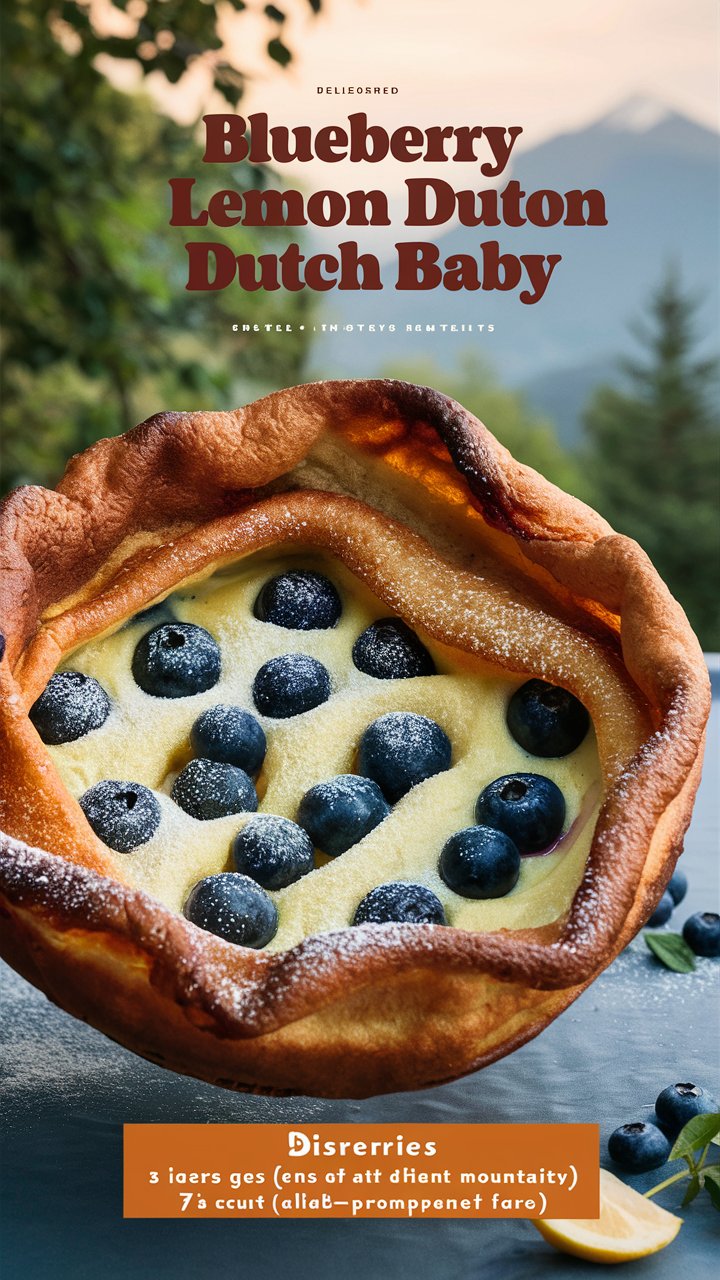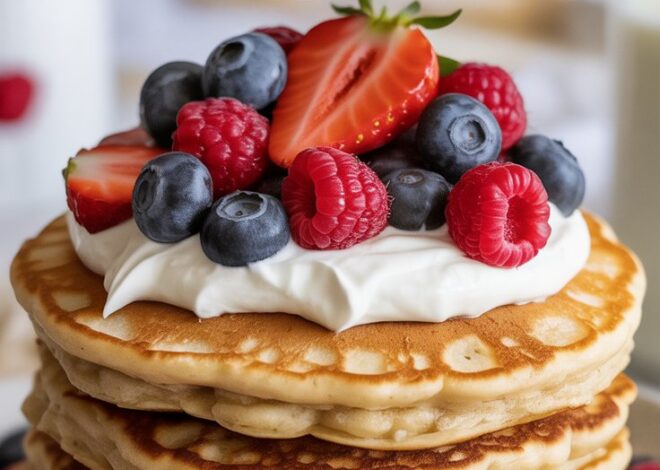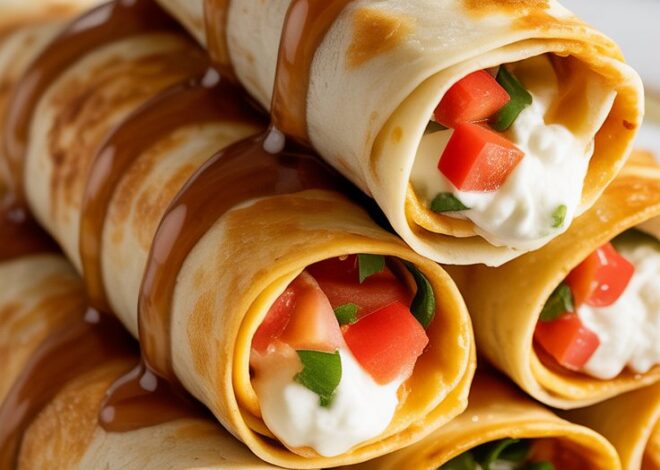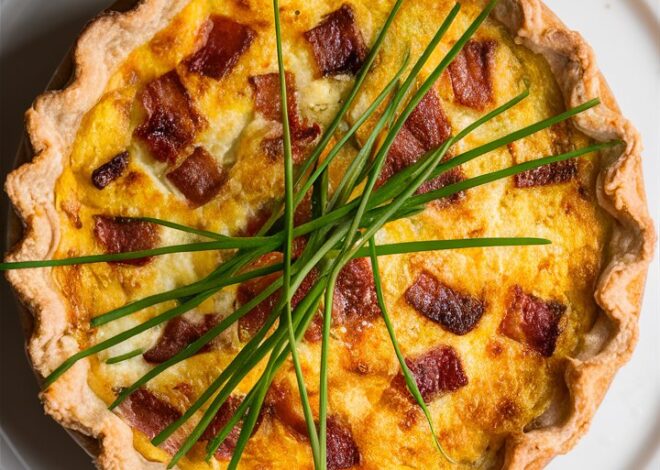
Elevate Your Breakfast with This Blueberry Lemon Dutch Baby Recipe 2025
There’s something undeniably magical about a dish that’s as easy to make as it is spectacular to serve. The Dutch baby pancake, also known as a German pancake or a puffed oven pancake, is exactly that. With crispy edges, a soft custard-like center, and a dramatic puffed appearance, it has become a favorite in kitchens worldwide.
In this article, we take the traditional Dutch baby to new heights by pairing it with vibrant, tangy lemon and sweet, juicy blueberries. The result? A show-stopping Blueberry Lemon Dutch Baby—a dish that’s perfect for breakfast, brunch, or even dessert.
In this in-depth guide, you’ll learn:
- The fascinating history of Dutch baby pancakes
- The essential ingredients and their roles
- Step-by-step instructions for foolproof results
- Pro tips for perfecting texture and flavor
- Variations and creative topping ideas
- Storage and reheating techniques
- Nutritional insights and dietary adaptations
- Frequently asked questions answered by baking experts
Whether you’re a beginner home cook or an experienced baker looking for your next signature brunch dish, this comprehensive guide will equip you with everything you need to master the Blueberry Lemon Dutch Baby.
The Origins of the Dutch Baby Pancake
Despite its name, the Dutch baby isn’t from the Netherlands. In fact, its roots can be traced to German immigrants who brought their traditional Pfannkuchen (a type of pancake) recipes to America. The term “Dutch baby” is thought to have emerged from a misinterpretation of “Deutsch” (the German word for “German”).
The recipe gained popularity in the United States in the early 20th century, particularly in Seattle, where a local restaurant helped popularize the dramatic puffed pancake baked in a cast-iron skillet.
What sets the Dutch baby apart from traditional pancakes is its unique baking method:
- The batter is poured into a hot, buttered skillet and baked at a high temperature.
- The steam generated from the high heat causes it to puff dramatically.
- As it cools, the center collapses slightly, leaving crispy edges and a soft, custardy middle.
Why Blueberry Lemon? A Perfect Flavor Pairing
When it comes to fruit pairings, few combinations are as refreshing and complementary as lemon and blueberry. Here’s why this duo works so well:
- Lemon provides bright, tangy acidity that cuts through the richness of the pancake.
- Blueberries offer natural sweetness and juicy bursts of flavor.
- Together, they create a balanced, vibrant taste that elevates the classic Dutch baby.
This pairing also offers visual appeal. The deep blue of the berries contrasts beautifully with the golden brown crust and the sunny yellow lemon zest and slices.
Key Ingredients & Their Purpose
Understanding each ingredient’s role ensures better results and allows you to experiment confidently. Here’s a breakdown of the ingredients used in this recipe:
Eggs
- The star of the recipe.
- Provide structure, richness, and help the pancake rise.
- At least three large eggs are essential for proper lift.
Whole Milk
- Adds moisture and creaminess.
- The fat content helps create a tender center.
- Whole milk is ideal, but other milk types can be substituted.
All-Purpose Flour
- Gives body to the pancake.
- A moderate amount keeps the texture light without being doughy.
Granulated Sugar
- Adds a subtle sweetness.
- Helps caramelize the edges for a golden crust.
Vanilla Extract
- Enhances the overall aroma and flavor with warm, sweet notes.
Salt
- Balances sweetness and enhances all the other flavors.
Lemon Zest & Juice
- Lemon zest adds concentrated citrus flavor.
- Lemon juice brightens the dish and balances the sweetness.
Unsalted Butter
- Essential for creating crispy edges.
- Imparts a rich, nutty flavor when browned in the skillet.
Fresh Blueberries
- Provide bursts of natural sweetness and color.
- Additional berries can be added for garnish.
Powdered Sugar
- Used for dusting after baking, adding sweetness and a beautiful finish.
Optional Garnishes
- Lemon slices, whipped cream, or maple syrup for extra indulgence.
How to Make Blueberry Lemon Dutch Baby: Step-by-Step
Here’s a detailed guide to help you make the perfect Dutch baby, every time.
Step 1: Preheat Your Oven and Skillet
- Preheat your oven to 425°F (220°C).
- Place a well-seasoned cast-iron skillet (10-inch preferred) inside the oven to heat.
- This step is crucial for achieving the signature puff and crispy edges.
Step 2: Prepare the Batter
- In a blender, combine:
- 3 large eggs
- ¾ cup whole milk
- ½ cup all-purpose flour
- 1 tablespoon granulated sugar
- ½ teaspoon vanilla extract
- ¼ teaspoon salt
- Zest of 1 lemon
- Blend until smooth and frothy, about 30 seconds.
- Allow the batter to rest for 10 minutes to ensure the flour fully absorbs the liquid.
Pro Tip: If you don’t have a blender, whisk the ingredients by hand until smooth.
Step 3: Melt Butter and Add Batter
- Carefully remove the hot skillet from the oven.
- Add 2 tablespoons unsalted butter and swirl to coat the pan’s bottom and sides.
- Immediately pour the batter into the skillet.
- Scatter ½ cup fresh blueberries evenly over the batter.
Step 4: Bake the Dutch Baby
- Return the skillet to the oven and bake for 15 to 18 minutes.
- Watch as it dramatically puffs up and turns golden brown.
- Avoid opening the oven during baking to prevent deflation.
Step 5: Garnish and Serve
- Once fully baked, remove the skillet from the oven.
- Drizzle with 1 tablespoon fresh lemon juice.
- Dust generously with powdered sugar.
- Garnish with extra blueberries and lemon slices.
- Serve immediately for the best texture and flavor.
Tips for Success
- Preheat Everything: The oven and skillet must be hot to generate steam for puffing.
- Blend Thoroughly: A smooth batter ensures even baking.
- Don’t Skip Resting: Resting the batter reduces gluten formation and improves rise.
- Use Fresh Lemons: Fresh zest and juice offer superior flavor.
- Serve Quickly: Dutch babies deflate fast after baking, so serve immediately.
Creative Variations
This dish is endlessly customizable! Try these variations:
- Berry Medley Dutch Baby: Combine blueberries with raspberries, strawberries, or blackberries.
- Citrus Explosion: Add orange zest along with lemon for a citrus-forward version.
- Savory Twist: Omit sugar and fruit, and top with herbs, cheese, and cooked bacon.
- Chocolate Indulgence: Add dark chocolate chips for a dessert-ready Dutch baby.
Topping Ideas
Take your Dutch baby to the next level with creative toppings:
- Whipped cream
- Greek yogurt
- Lemon curd
- Crushed nuts
- Honey or agave syrup
- Maple syrup
- Cinnamon sugar dusting
How to Store & Reheat
While Dutch babies are best fresh, you can store leftovers:
- Refrigeration: Cool completely, then store in an airtight container for up to 2 days.
- Reheating: Warm in a 300°F (150°C) oven for about 5 minutes. Avoid microwaving, as it softens the crisp texture.
Nutritional Insights (Per Serving, Approximate)
| Nutrient | Amount |
|---|---|
| Calories | 220 |
| Carbohydrates | 28g |
| Protein | 7g |
| Fat | 9g |
| Saturated Fat | 4g |
| Fiber | 1g |
| Sugar | 9g |
| Sodium | 160mg |
Note: Nutritional values may vary based on exact ingredients and portion sizes.
Frequently Asked Questions
Can I use frozen blueberries?
Yes! Use frozen blueberries directly from the freezer without thawing to prevent sogginess.
Why didn’t my Dutch baby puff up?
Common reasons:
- Oven or skillet wasn’t hot enough.
- Batter wasn’t blended thoroughly.
- Opening the oven door too early.
Can I make this gluten-free?
Yes! Use a 1:1 gluten-free baking flour blend for similar results.
Can I make it dairy-free?
Absolutely! Swap dairy milk for almond, oat, or soy milk, and use plant-based butter or coconut oil.
How far in advance can I make the batter?
You can refrigerate the batter overnight. Bring it to room temperature before baking for optimal puff.
What’s the best skillet to use?
A cast-iron skillet is best for its heat retention. An oven-safe nonstick or stainless steel skillet also works.
Can I double the recipe?
Yes, but use a larger skillet (12 inches or more) and slightly extend the baking time.
Conclusion: A Recipe Worth Mastering
The Blueberry Lemon Dutch Baby isn’t just a recipe—it’s an experience. Its simplicity, visual appeal, and incredible flavor make it a standout dish for any occasion, from quiet mornings to festive brunch gatherings.
With its crisp edges, soft custard-like center, and vibrant blend of blueberries and lemon, this Dutch baby is sure to impress. Plus, it’s endlessly customizable, allowing you to experiment with various toppings, fruits, and flavor combinations.
Whether you’re a seasoned baker or a kitchen novice, this comprehensive guide provides everything you need to create the perfect Dutch baby every time. It’s a dish you’ll return to again and again—not just because it’s easy, but because it’s truly irresistible.
Try This Recipe Today!
If you’ve never baked a Dutch baby before, now’s the perfect time to give it a try. Follow this guide, make it your own, and share it with family and friends—you won’t regret it.


